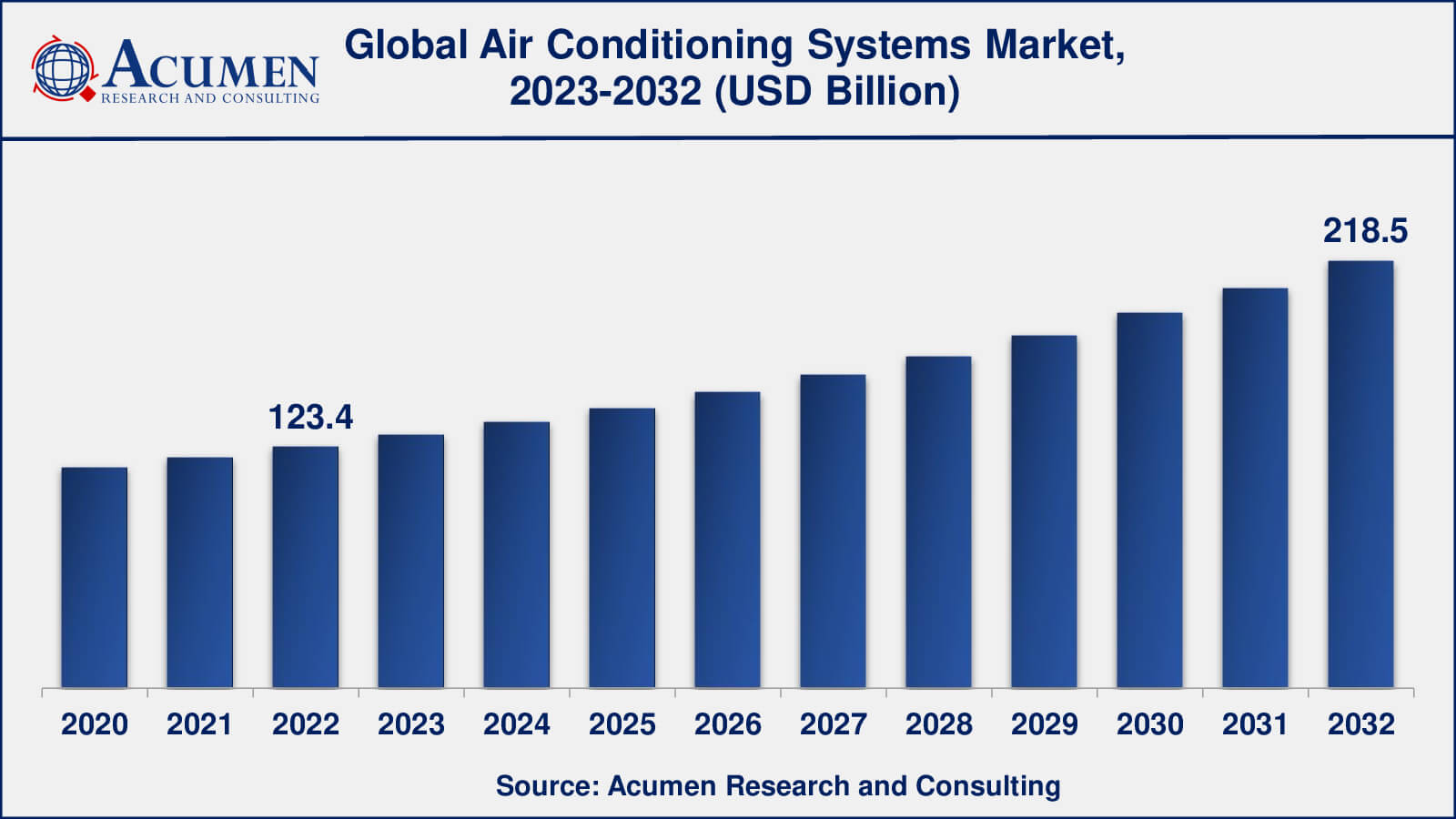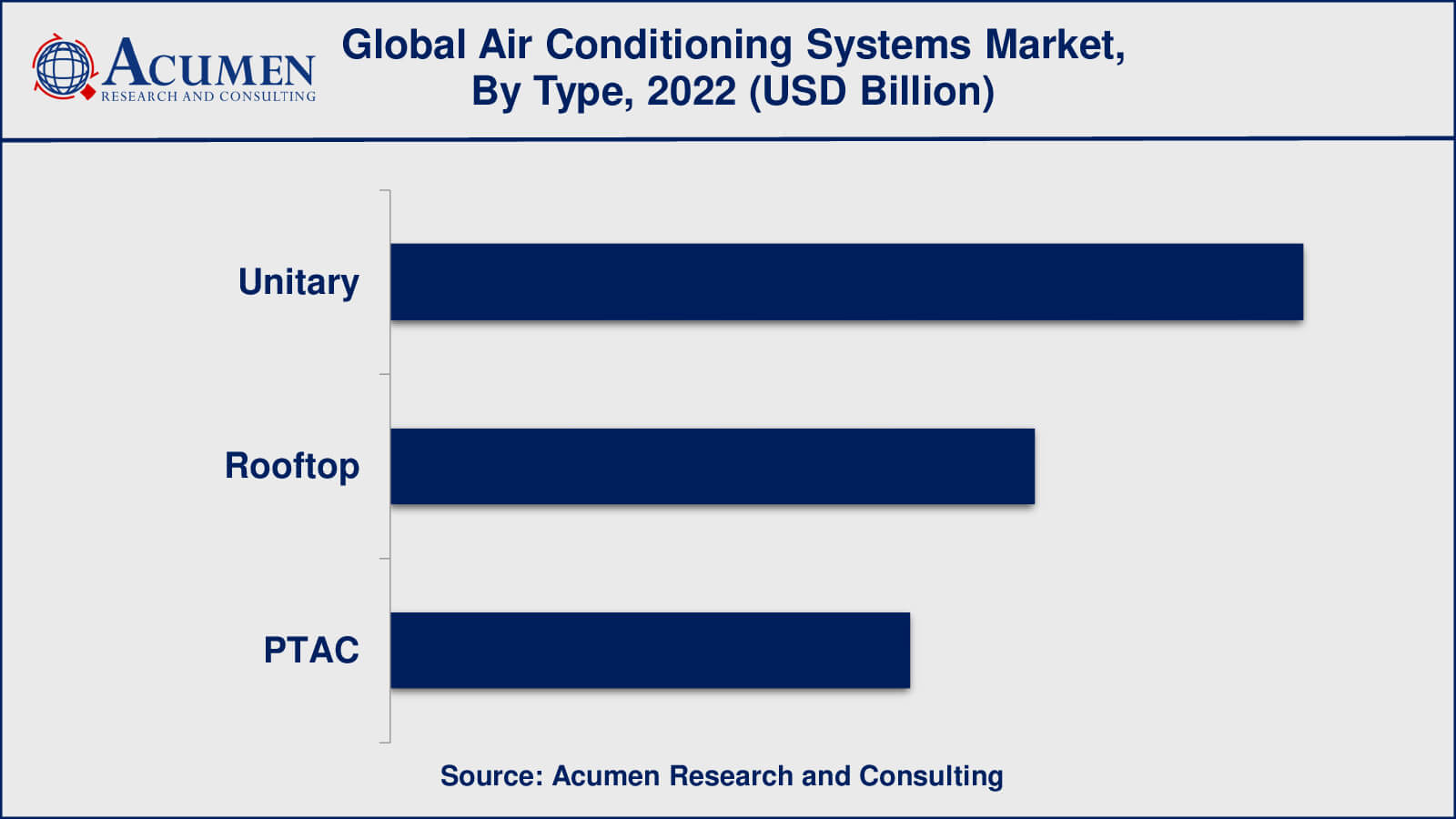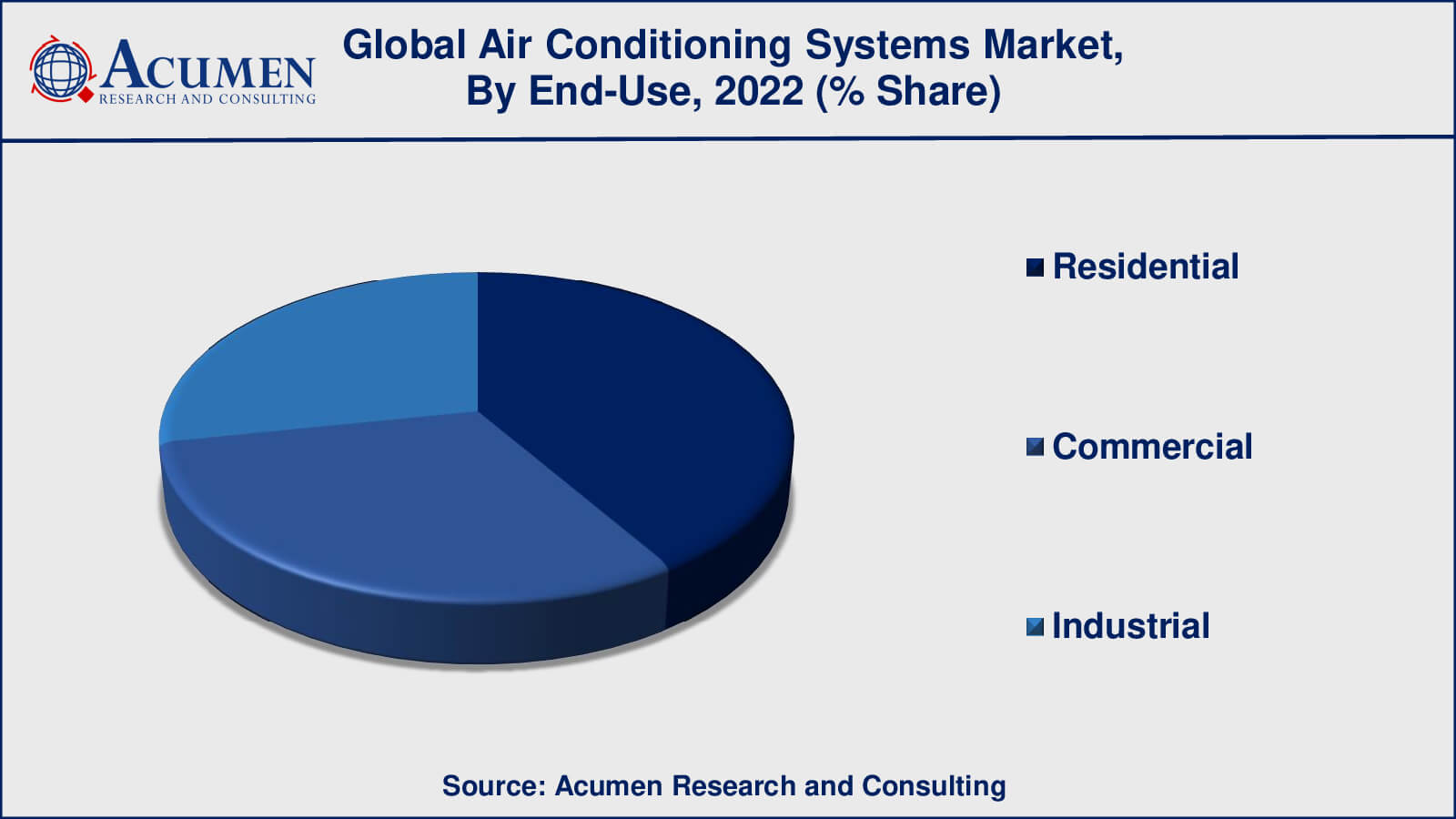Air Conditioning Systems Market Size - Global Industry, Share, Analysis, Trends and Forecast 2023 - 2032
Published :
Report ID:
Pages :
Format :
Air Conditioning Systems Market Size - Global Industry, Share, Analysis, Trends and Forecast 2023 - 2032
Report Coverage
- Industry Dynamics
- Market Size and Forecast Data
- Segment Analysis
- Competitive Landscape
- Regional Analysis with a Niche Focus on Country-Level Data
- High Level Analysis - Porter's, PESTEL, Value Chain, etc.
- Company Profiles of Key Players
- Option to Customize the Report As Per Your Specific Need
Request Sample Report
The Global Air Conditioning Systems Market Size collected USD 123.4 Billion in 2022 and is set to achieve a market size of USD 218.5 Billion in 2032 growing at a CAGR of 6.0% from 2023 to 2032.
Air Conditioning Systems Market Report Statistics
- Global Air Conditioning Systems market revenue is estimated to reach USD 218.5 Billion by 2032 with a CAGR of 6.0% from 2023 to 2032
- Asia-Pacific Air Conditioning Systems market value occupied more than USD 4.6 billion in 2022
- North America Air Conditioning Systems market growth will record a CAGR of over 4.8% from 2023 to 2032
- Among type, the Rooftop Air Conditioning Systems sub-segment generated around 51% share in 2022
- Based on lubrication, the crop spray generated more than US $ 18.3 billion revenue in 2022
- Technological advancements is a popular air conditioning systems market trend that fuels the industry demand

Air conditioning systems have witnessed a significant surge in demand especially from commercial End-Uses. Residential End-Uses of air conditioning systems are also expected to account for a rapid growth of global air conditioning systems market. Increasing popularity of inverter air conditioners and smart thermostats is resulting in increasing adoption of air conditioning systems across the globe. Manufacturers of air conditioning systems are focusing on energy efficiency, and are emphasizing on global concerns over energy conservation. Concerns towards air pollution are also expected to spur the need for air purifying mechanisms. Presence of a numerous leading players in the global air conditioning systems market is making the market immensely competitive. This is anticipated to drive the market at a significant growth rate over the forecast period. Increasing levels of living standards and comfort level depends on the surrounding environment to a large extent. Air pressure, humidity and temperature are some of the crucially important variables of environment which keep changing over the time. Moreover, in order to keep control on environmental conditions, smart air conditioning systems play an important role. Air conditioning can be referred as the simultaneous control of moisture, temperature, cleanliness and motion.

Global Air Conditioning Systems Market Dynamics
Market Drivers
- Increasing demand for energy-efficient solutions
- Rapid urbanization and industrialization
- Technological advancements
Market Restraints
- High initial cost
- Availability of alternative solutions
Market Opportunities
- Government regulations and initiatives
- Increasing disposable income
Air Conditioning Systems Market Report Coverage
| Market | Air Conditioning Systems Market |
| Air Conditioning Systems Market Size 2022 | USD 123.4 Billion |
| Air Conditioning Systems Market Forecast 2032 | USD 218.5 Billion |
| Air Conditioning Systems Market CAGR During 2023 - 2032 | 6.0% |
| Air Conditioning Systems Market Analysis Period | 2020 - 2032 |
| Air Conditioning Systems Market Base Year | 2022 |
| Air Conditioning Systems Market Forecast Data | 2023 - 2032 |
| Segments Covered | By Type, By Technology, By Lubrication, By End-Use, And By Geography |
| Regional Scope | North America, Europe, Asia Pacific, Latin America, and Middle East & Africa |
| Key Companies Profiled | Mitsubishi Corporation, Daikin Industries Ltd., Samsung Electronics, Haier Electronics Group Co., LG Electronics, Electrolux AB, Carrier Corporation, Panasonic Corporation, Sharp Corporation, Hitachi Ltd., Hisense International Co. Ltd., The Midea Group and Gree Electric Appliances, Inc. |
| Report Coverage |
Market Trends, Drivers, Restraints, Competitive Analysis, Player Profiling, Covid-19 Analysis, Regulation Analysis |
Air Conditioning Systems Market Growth Factors
With the advancements in technology, the global air conditioning systems market is expected to witness a wide range of product innovations and development. Natural refrigerants and inverter based air conditioning systems are anticipated to bring surge in the demand considerably. In addition, increasing need for power saving especially in developed economies as well as stringent regulations and policies regarding improved ways of energy utilization in United States coupled with enhanced consumer awareness is expected to boost the demand for air conditioning systems. Furthermore, air conditioning systems employ refrigerants which are toxic and detrimental and are expected to substantially contribute towards global warming. Hence, alternative products available in the global market are projected to accelerate the growth of global air conditioning systems market over the forecast period.
Increasing improvement in standard of living is a key factor driving the growth of global air conditioner systems market. Also, packaged air conditioners are expected to witness a surge at moderate rate due to growth of construction industry including offices, shopping malls, and other industries. Split air conditioners offer a lot of benefits such as low initial cost, less noise and feasible installations. Split air conditioning systems accounts for more than half of the total revenue share and is anticipated to remain a dominant segment over the forecast period. Moreover, use of air conditioning systems based on solar energy and other conventional energy sources is a key factor driving the global air conditioning systems market. However, stringent regulations on energy and power consumption coupled with increasing consumer awareness regarding energy savings are some key restraints in the global air conditioning systems market.
Air Conditioning Systems Market Segmentation
The worldwide air conditioning systems market is categorized based on type, technology, lubrication, end-use, and geography.
Air Conditioning Systems Market By Type
- Unitary
- Rooftop
- PTAC

According to the forecast for the air conditioning systems market, unitary air conditioning systems will account for the majority of market shares from 2023 to 2032. Unitary systems, which can be window-mounted or split systems, are typically designed for individual rooms or small spaces. These systems are commonly found in residences, small offices, and other light commercial spaces. Rooftop air conditioning systems are also popular, especially in larger commercial structures. Rooftop systems are intended to be installed on a building's roof and can provide cooling for multiple rooms or floors. Although these systems are frequently more expensive than unitary systems, they can be more efficient and easier to maintain. Packaged terminal air conditioner (PTAC) systems are another type of air conditioning system found in hotels, motels, and other commercial establishments. These systems, which can provide both heating and cooling, are designed to be installed through a wall.
Air Conditioning Systems Market By Technology
- Inverter
- Non-Inverter
Inverter air conditioning systems have dominated the market for air conditioning systems in recent years. Inverter technology employs a variable speed compressor that can adjust its speed in response to the room's cooling or heating requirements. This enables the system to run more efficiently than non-inverter systems that use a fixed speed compressor. Inverter air conditioning systems use less energy and offer more precise temperature control than non-inverter systems. They are also quieter and have a longer lifespan due to less wear and tear on the compressor. Non-inverter systems, on the other hand, use a fixed speed compressor that starts up at full power and shuts down when the desired temperature is reached. Non-inverter systems are less expensive than inverter systems in general, but they are less efficient and may not provide as precise temperature control.
Air Conditioning Systems Market By End-Use
- Residential
- Commercial
- Industrial

Residential air conditioning systems have traditionally been the largest end-use segment of the market, accounting for a significant market share, according to air conditioning systems industry analysis. The demand for residential air conditioning systems is expected to rise further as urbanization continues and there is a greater demand for comfortable living environments. A significant end-use segment of the market is commercial air conditioning systems, which include systems used in office buildings, retail spaces, and healthcare facilities. Factors such as the need for pleasant working environments and the increasing construction of commercial buildings in emerging markets drive demand for commercial air conditioning systems. Industrial air conditioning systems, such as those used in manufacturing plants, data centers, and other industrial facilities, are also a significant market end-use segment. Factors such as the need for exact temperature control in industrial processes and the increasing construction of industrial facilities drive demand for industrial air conditioning systems.
Air Conditioning Systems Market Regional Outlook
North America
- U.S.
- Canada
Europe
- U.K.
- Germany
- France
- Spain
- Rest of Europe
Asia-Pacific
- India
- Japan
- China
- Australia
- South Korea
- Rest of Asia-Pacific
Latin America
- Brazil
- Mexico
- Rest of Latin America
The Middle East & Africa
- South Africa
- GCC Countries
- Rest of the Middle East & Africa (ME&A)
Air Conditioning Systems Market Regional Analysis
The North American market for air conditioning systems is driven by factors such as the demand for energy-efficient and sustainable cooling solutions, as well as the increasing demand for residential and commercial air conditioning systems. The US and Canada are the major markets in this region.
The European air conditioning systems market is being driven by factors such as increased commercial building construction, increased demand for energy-efficient and sustainable cooling solutions, and favorable government regulations. The major markets in this region are Germany, France, and the United Kingdom.
Factors such as growing urbanization, rising disposable incomes, and a desire for comfortable living and working environments drive the Asia-Pacific market for air conditioning systems. The major markets in this region are China, India, and Japan.
Air Conditioning Systems Market Players
Some of the key players in the global air conditioning systems market include Mitsubishi Corporation, Daikin Industries Ltd., Samsung Electronics, Haier Electronics Group Co., LG Electronics, Electrolux AB, Carrier Corporation, Panasonic Corporation, Sharp Corporation, Hitachi Ltd., Hisense International Co. Ltd., The Midea Group and Gree Electric Appliances, Inc.
Frequently Asked Questions
How big is the air conditioning systems market?
The air conditioning systems market size was USD 123.4 Billion in 2022.
What is the CAGR of the global air conditioning systems market during forecast period of 2023 to 2032?
The CAGR of air conditioning systems market is 6.0% during the analysis period of 2023 to 2032.
Which are the key players operating in the market?
The key players operating in the global market are Mitsubishi Corporation, Daikin Industries Ltd., Samsung Electronics, Haier Electronics Group Co., LG Electronics, Electrolux AB, Carrier Corporation, Panasonic Corporation, Sharp Corporation, Hitachi Ltd., Hisense International Co. Ltd., The Midea Group and Gree Electric Appliances, Inc.
Which region held the dominating position in the global air conditioning systems market?
North America held the dominating position in air conditioning systems market during the analysis period of 2023 to 2032.
Which region registered the fastest growing CAGR for the forecast period of 2023 to 2032?
Asia-Pacific region exhibited fastest growing CAGR for air conditioning systems market during the analysis period of 2023 to 2032.
What are the current trends and dynamics in the global air conditioning systems market?
The current trends and dynamics in the air conditioning systems industry include increasing demand for energy-efficient solutions, rapid urbanization and industrialization, and technological advancements.
Which type held the maximum share in 2022?
The unitary ACs type held the maximum share of the air conditioning systems market.



